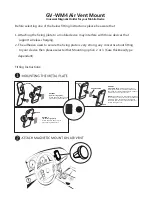
Electro-magnetic interference (EMI) and leakage currents
Precautions for use of the inverter
3 - 6
3.1.2 Countermeasures
against inverter-generated EMI
Some electromagnetic noises enter the inverter to malfunction it, and others are radiated by the in-
verter to cause the peripheral devices to malfunction. Though the inverter is designed to have high
immunity performance, it handles low-level signals, so it requires the following basic techniques. Al-
so, since the inverter chops outputs at high carrier frequency, that could generate electromagnetic
noises. If these electromagnetic noises cause peripheral devices to malfunction, EMI countermeas-
ures should be taken to suppress noises. These techniques differ slightly depending on EMI paths.
●
Basic techniques
–
Do not run the power cables (I/O cables) and signal cables of the inverter in parallel with each
other and do not bundle them.
–
Use shielded twisted pair cables for the detector connecting and control signal cables and
connect the sheathes of the shielded cables to terminal SD.
–
Ground (Earth) the inverter, motor, etc. at one point.
●
Techniques to reduce electromagnetic noises that enter and cause a malfunction of the inverter
(EMI countermeasures)
When devices that generate many electromagnetic noises (which use magnetic contactors,
electromagnetic brakes, many relays, for example) are installed near the inverter and the inverter
may malfunction due to electromagnetic noises, the following countermeasures must be taken:
–
Provide surge suppressors for devices that generate many electromagnetic noises to suppress
electromagnetic noises.
–
Install data line filters (page 3-8) to signal cables.
–
Ground (Earth) the shields of the detector connection and control signal cables with cable
clamp metal.
●
Techniques to reduce electromagnetic noises that are radiated by the inverter to cause the
peripheral devices to malfunction (EMI countermeasures)
Inverter-generated noises are largely classified into
–
those radiated by the cables connected to the inverter and inverter main circuits (I/O),
–
those electromagnetically and electrostatically induced to the signal cables of the peripheral
devices close to the main circuit power supply,
–
and those transmitted through the power supply cables.
I001048E
Fig. 3-3:
Noise propagation
Inverter
generated noise
Air propagated
noise
Noise directly radiated
from inverter
Noise radiated from
power supply cable
Noise radiated from
motor connection cable
Electromagnetic
induction noise
Electrostatic
induction noise
Electrical path
propagated noise
Noise propagated
through power supply
cable
Noise from earthing
(grounding) cable due
to leakage current
... Path
... Path
... Path
... Path
... Path
... Path
... Path
Summary of Contents for FR-A800
Page 2: ......
Page 4: ......
Page 22: ...Contents XVIII ...
Page 30: ...Related manuals Introduction 1 8 ...
Page 122: ...Connection of stand alone option units Installation and wiring 2 92 ...
Page 180: ...Basic operation procedure JOG operation Basic operation 4 32 ...
Page 934: ...Check first when you have a trouble Protective functions 6 46 ...
Page 1031: ...Appendix EC Declarations of Conformity FR A800 A 47 ...
Page 1032: ...EC Declarations of Conformity Appendix A 48 ...
Page 1033: ...Appendix EC Declarations of Conformity FR A800 A 49 ...
Page 1034: ...EC Declarations of Conformity Appendix A 50 ...
Page 1035: ...Appendix EC Declarations of Conformity FR A800 A 51 A 5 2 EMC Directive ...
Page 1036: ...EC Declarations of Conformity Appendix A 52 ...
Page 1037: ...Appendix EC Declarations of Conformity FR A800 A 53 ...
Page 1038: ...EC Declarations of Conformity Appendix A 54 ...
Page 1039: ...Appendix EC Declarations of Conformity FR A800 A 55 ...
Page 1040: ...EC Declarations of Conformity Appendix A 56 ...
Page 1041: ......
















































